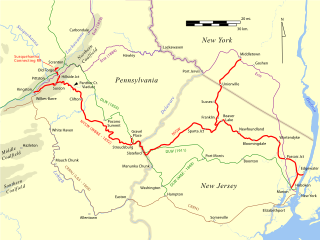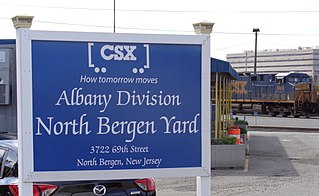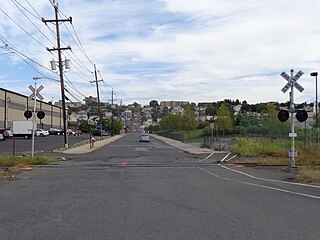
The New York, Susquehanna and Western Railway, also sometimes referred to as New York, Susquehanna and Western Railroad, Susie-Q or the Susquehanna, is a Class II American freight railway operating over 400 miles (645 km) of track in three Northeastern states, New Jersey, New York, and Pennsylvania.

The Main Line is a commuter rail line owned and operated by New Jersey Transit running from Suffern, New York to Hoboken, New Jersey, in the United States. It runs daily commuter service and was once the north–south main line of the Erie Railroad. It is colored yellow on NJ Transit system maps, and its symbol is a water wheel.

The Bergen County Line is a commuter rail line and service owned and operated by New Jersey Transit in the U.S. state of New Jersey. The line loops off the Main Line between the Meadowlands and Glen Rock, with trains continuing in either direction along the Main Line. It is colored on NJT system maps in grey, and its symbol is a cattail, which are commonly found in the Meadowlands where the line runs.

For the purposes of this article, the Jersey City area extends North to Edgewater, South to Bayonne and includes Kearny Junction and Harrison but not Newark. Many routes east of Newark are listed here.

The Northern Branch is a railroad line that runs from Jersey City to Northvale in northeastern New Jersey, and formerly extended further into New York State. The line was constructed in 1859 by the Northern Railroad of New Jersey to connect the New York and Erie Railroad's Piermont Branch terminus in Piermont, New York, directly to Erie's primary terminal in Jersey City, initially Exchange Place, later Pavonia Terminal. In 1870 the line was extended to Nyack, New York, and continued to provide passenger service until 1966. After the Erie's unsuccessful merger with the Lackawanna Railroad to form the Erie-Lackawanna, ownership of the line passed into the hands of Conrail upon its formation in 1976 from a number of bankrupt railroads.

The New Jersey Midland Railway was a 19th-century predecessor to the New York, Susquehanna and Western Railway (NYS&W) that operated in Northern New Jersey and Orange County, New York.

Pavonia Terminal was the Erie Railroad terminal on the Hudson River located in the Harsimus section of Jersey City, New Jersey. The station opened in 1861 and closed in 1958 when the Erie Railroad moved its passenger services to nearby Hoboken Terminal. The New York, Susquehanna and Western Railway also ran commuter trains from the terminal and various street cars, ferries and the underground Hudson and Manhattan Railroad serviced the station. The station was abandoned in 1958 and demolished in 1961. The site was eventually redeveloped into the Newport district in the late 20th century.

The Passaic–Bergen–Hudson Transit Project is a project under study by NJ Transit to reintroduce passenger service on a portion of the New York, Susquehanna and Western Railway (NYSW) right-of-way (ROW) in Passaic, Bergen and Hudson counties using newly built, FRA-compliant diesel multiple unit rail cars. Plans call for service to run from Hawthorne south through Paterson, east to Hackensack and then southeast to North Bergen, where it would join the Hudson-Bergen Light Rail (HBLR).

The North Bergen Yard is freight rail yard and intermodal terminal in North Bergen, New Jersey parallel to Tonnelle Avenue between 49th and 69th Streets. Located within the North Jersey Shared Assets Area, the facility is part of CSX Transportation (CSXT) and the origination point of its CSX River Subdivision at the southern end of the Albany Division. On its west side, the New York, Susquehanna and Western Railway (NYSW) runs the length of the yard and operates a bulk transloading operation immediately adjacent to it.

Little Ferry Yard is a railyard and intermodal terminal in the Port of New York and New Jersey served by the CSX River Subdivision (CSXT), New York, Susquehanna and Western Railway (NYSW), Norfolk Southern Railway and Conrail Shared Assets Operations (CRCX).

Ridgefield Park station, also known as West Shore Station, was a railroad station in Ridgefield Park, New Jersey, at the foot of Mount Vernon Street served by the New York, Susquehanna and Western Railroad (NYSW) and the West Shore Railroad, a division of New York Central (NYCRR). The New York, Ontario and Western Railway (NYO&W) had running rights along the West Shore and sometimes stopped at Ridgefield Park. First opened in 1872 it was one of three passenger stations in the village, the others being the Little Ferry station to the south and Westview station to the north. Service on the West Shore Railroad began in 1883. The station house, built at a cost of $100,000 opened in 1927. Southbound service crossed Overpeck Creek and continued to terminals on the Hudson River waterfront where there was a connecting ferry service across the Hudson River to Manhattan. Northbound near Bogota the parallel NYSW and West Shore lines diverge and continue into northern New Jersey, Pennsylvania, and upstate New York. Passenger service ended in 1966.

Vreeland Avenue was railroad station in Paterson, New Jersey served by the New York, Susquehanna and Western Railroad (NYS&W). until 1966. Service by the New Jersey Midland, a predecessor to the NYS&W, had begun in 1873. The station house dates to 1949. Other extant station buildings from the New Jersey Midland/NYSW can be found at Wortendyke, Butler, and Newfoundland, among other places.

Wyckoff is a former commuter railroad train station in the township of Wyckoff, Bergen County, New Jersey. The station served trains of the New York, Susquehanna and Western Railway between Pavonia Terminal in Jersey City or Susquehanna Transfer in North Bergen to the station in Butler. The next station east was Wortendyke in Midland Park while the next one west was Campgaw station in Franklin Lakes. Wyckoff station consisted of one track and one low-level side platform for passenger service.

91st Street is a proposed station along the Northern Branch Corridor Project extension of Hudson-Bergen Light Rail in the Babbitt Section of North Bergen, New Jersey.

Bogota was a railroad station in Bogota, New Jersey, at Court Street/Fort Lee Road west of River Road and east of the Court Street Bridge over the Hackensack River. It was located on the New York, Susquehanna and Western Railway Main Line, which provided passenger service between the 1870s and 1960s.
69th Street is a proposed interchange station in North Bergen in Hudson County, New Jersey. It would serve passengers on two lines under consideration by NJ Transit, the Passaic–Bergen–Hudson Transit Project and the Northern Branch Corridor Project, the latter of which is an extension of the Hudson–Bergen Light Rail. The station would located at-grade west the North Bergen Yard and Tonnelle Avenue.

The Vince Lombardi Park & Ride is located on the New Jersey Turnpike in the Meadowlands in Ridgefield, Bergen County, New Jersey. The park and ride and separate service area to south of it are dedicated to and named after Vince Lombardi. Located at the edge of the Little Ferry Yard it has been viewed as a potential rail station location since the 1990s and as of 2021, it is under consideration by NJ Transit as part of the Passaic–Bergen–Hudson Transit Project.

Broadway–Paterson was a New York, Susquehanna and Western Railroad (NYS&W) station in Paterson, New Jersey near the level, or at-grade crossing south of Broadway at Ellison Place and Madison Avenue. Service by the New Jersey Midland, a predecessor to the NYS&W, had begun in 1873. It was originally known as Paterson, but was renamed after a junction of the railroad's mainline was created to build the Paterson City Branch. The station house, demolished in 1982, was situated between the two lines and served as the Susquehanna's headquarters for several years. Passenger service on the branch ended in 1960 and on the mainline in 1966.

North Bergen was a railroad station in North Bergen, New Jersey, United States known Homestead for most of its existence. It as built in the mid 19th century and served by the New York, Susquehanna and Western Railway (#1059) and the Erie Railroad's Northern Branch (#1903).




















